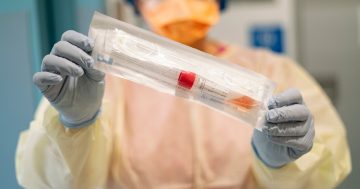
ACT Health has relaxed the quarantine period for household or high-risk contacts. Photo: Michelle Kroll.
ACT Health has reported 1226 new cases of COVID-19 overnight – the highest number of daily cases in more than two months.
The directorate has also announced relaxed post-COVID isolation requirements.
Previously, a person was not required to re-quarantine or get tested again if identified as a household or high-risk contact within four weeks of clearing isolation.
That timeframe has now been extended to eight weeks.
ACT Health said “people should not be tested for COVID-19” during this time, including if they develop symptoms, as part of a workplace screening program or if they are identified as a contact.
However, if a person develops symptoms within eight weeks of being cleared from isolation after the initial infection, they are asked to remain in isolation until they recover.
While the change wasn’t publicly announced, updates to the ACT Health website were published at the end of February.
It’s understood that infection with COVID-19 provides some immunity, although it’s unclear how long that immunity lasts. As of last week, ACT Health confirmed to Region Media that authorities are not aware of anyone who has been reinfected with the same variant of the virus.
Acting Chief Health Officer Dr Vanessa Johnston said today (16 March) it is possible to get multiple variants, but it’s “much less likely” because a person receives some cross-immunity from their previous infection.
The initial four-week timeframe for recovered cases was implemented around Christmas as cases exploded and the promised “normal” summer didn’t eventuate.

Chief Minister Andrew Barr said he would not be pushed into making “grandiose, sweeping statements” as Prime Minister Scott Morrison does. Photo: Facebook.
Chief Minister Andrew Barr confirmed yesterday that the ACT would not change the current quarantine advice for high-risk and household contacts until it receives advice specific to the Territory from the Australian Health Protection Principal Committee (AHPPC).
He defended his government’s “cautious” approach to the pathway forward, noting while the Prime Minister had tried to “railroad” the states into adopting a common position, it had been met with “fierce resistance” at last week’s National Cabinet.
Over the weekend, Mr Morrison described the current isolation rules for close contacts as “redundant”, but Mr Barr said he would not be pushed into making “grandiose, sweeping statements”.
As flagged a number of weeks ago, the current quarantine rules for close contacts in early childhood settings may soon be relaxed to fall into line with the settings currently in place at schools.
Dr Johnston said she understood the Education Directorate has been provided with the health advice to allow it to “step down” its approach and the early childhood sector had been advised of this yesterday.
Parents should be receiving this information in the coming days if they haven’t already.
“That will mean staff and kids in those settings that have had an exposure won’t need to quarantine,” she explained. Instead, people will need to return a negative test before returning to the setting.
Currently, there are 39 people in the Territory’s hospitals, including four in ICU. None require ventilation. Yesterday, there were 40 people in hospital.
The 1226 new cases (536 PCR and 690 RAT) reported today take the total number of active cases in the ACT to 4339 (1971 PCR and 2368 RAT).
Since the pandemic began, 61,857 (41,261 PCR and 20,596 RAT) cases of COVID-19 have been reported in the ACT.
The double-dose vaccination rate for the ACT’s five-plus population is 94.9 per cent, and 70.8 per cent of residents aged 16 and older have received a booster.
Of ACT residents aged five to 11, 79.3 per cent have received two doses.
Interstate, NSW has reported five deaths overnight and 30,402 new cases.
Those high case numbers have been attributed to “a processing error” which meant around 10,000 positive rapid antigen test results registered between Sunday, 13 March, and Monday, 14 March, were instead reported today.
There are now 1016 people in hospital with the virus and 36 people in ICUs around the state.
Victoria has reported eight deaths overnight and an additional 9426 cases of COVID-19.
There are now 201 people hospitalised with the virus, while 24 patients are in the state’s intensive care units.















